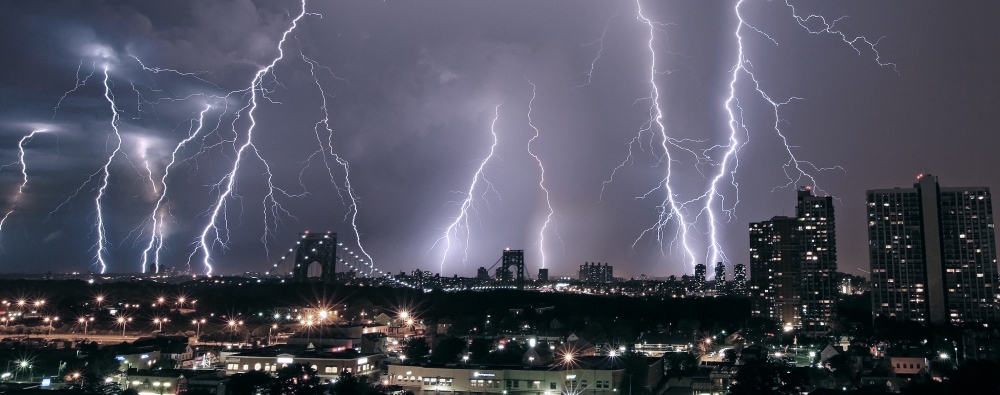
In order to ensure safety of people, facilities, equipment and materials from thermal, mechanical and electrical effects of lightning, a special system of protective security measures - lightning protection, which is a set of technical solutions and special adaptations, was developed.
Statutory regulation
Requirements to the organization of lightning protection systems for buildings and structures located on the territory of the Russian Federation shall be governed by the following regulations:
- "Instructions for lightning protection of buildings and structures" RD 34.21.122-87
- "Instructions for lightning protection of buildings, structures and industrial communications" industry standard 153-34.21.122-2003.
Developing the system of protective measures against lightning strikes of objects, design organizations may be guided by the provisions of any instruction or use a combination of both.
Elements of lightning protection
Full set of lightning protection measures of ground objects involves a combination of external systems - from direct lightning strikes and internal lightning protection - protection devices from the secondary effects (pick-up effect and Surge). External lightning protection provides a minimum chance of a direct hit of lightning into the building, thus protecting it from damage. It takes a lightning strike upon itself, which is then diverted to the ground.
The set of measures of external lightning protection system includes three elements:
- Lightning rod (lightning conductor, lightning arrester) - a device designed for interception of lightning. Air terminal operating principle is that the thunderbolt falls on the highest and well-grounded metallic structures. Therefore, if an object is located in the protection zone of the lightning rod, it will not be struck by lightning.
- Down conductor - a device that performs drainage of the lightning current from the air terminal to the grounding. It is mounted on the wall of the construction and downspouts. It is a copper covered wire or tape, which stretches from an air terminal to the ground electrode system.
- Ground electrode system - a device that performs drainage of 50% or more of lightning current transmitted into the ground through the down conductor. The remaining current is distributed to the communications adjacent to the construction. Ground electrode is the only element of external lightning protection, submerged in soil. Elements of different sizes, materials and shapes that meet the requirements of regulatory documents can be ground electrodes.
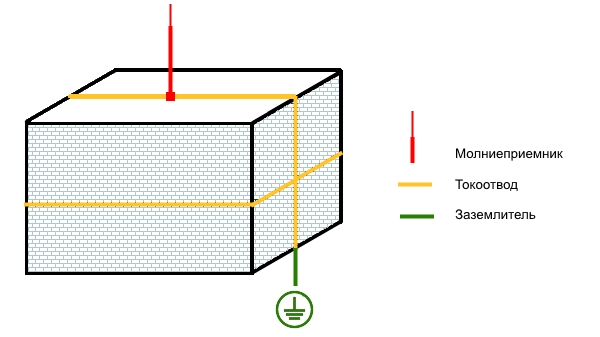
Молниеприемник – lightning rod
Токоотвод – down conductor
Заземлитель – ground electrode
It is possible to mount external lightning protection system both on the protected object, and in isolation: in the form of separate lightning rods and adjacent structures that perform function of a natural lightning rod.
Internal lightning protection includes a range of devices protecting against surge overvoltage (SPD) and serves functions of limiting magnetic and electric fields of lightning, thereby preventing sparkage inside the protected object.
2. Lightning rod as a part of lightning protection system
Lightning protection system is organized on the principle of maximum use of natural lightning rods. In cases where the security provided by them is not sufficient, then it is combined with specially installed elements (artificial lightning rods).
Simplicity of devices, lack of need for special maintenance and relatively reliable protection of the object from destruction by a lightning strike, provided wide use to lightning rods of passive lightning protection systems .
There are following types of passive lightning rods:
- rod (mast);
- catenary wire;
- mesh cage.
Lightning rods are made of different materials: aluminum, copper, stainless or galvanized steel, consdering the minimum cross-sections for each of them according to the regulations.
Rod lightning arrester (mast)
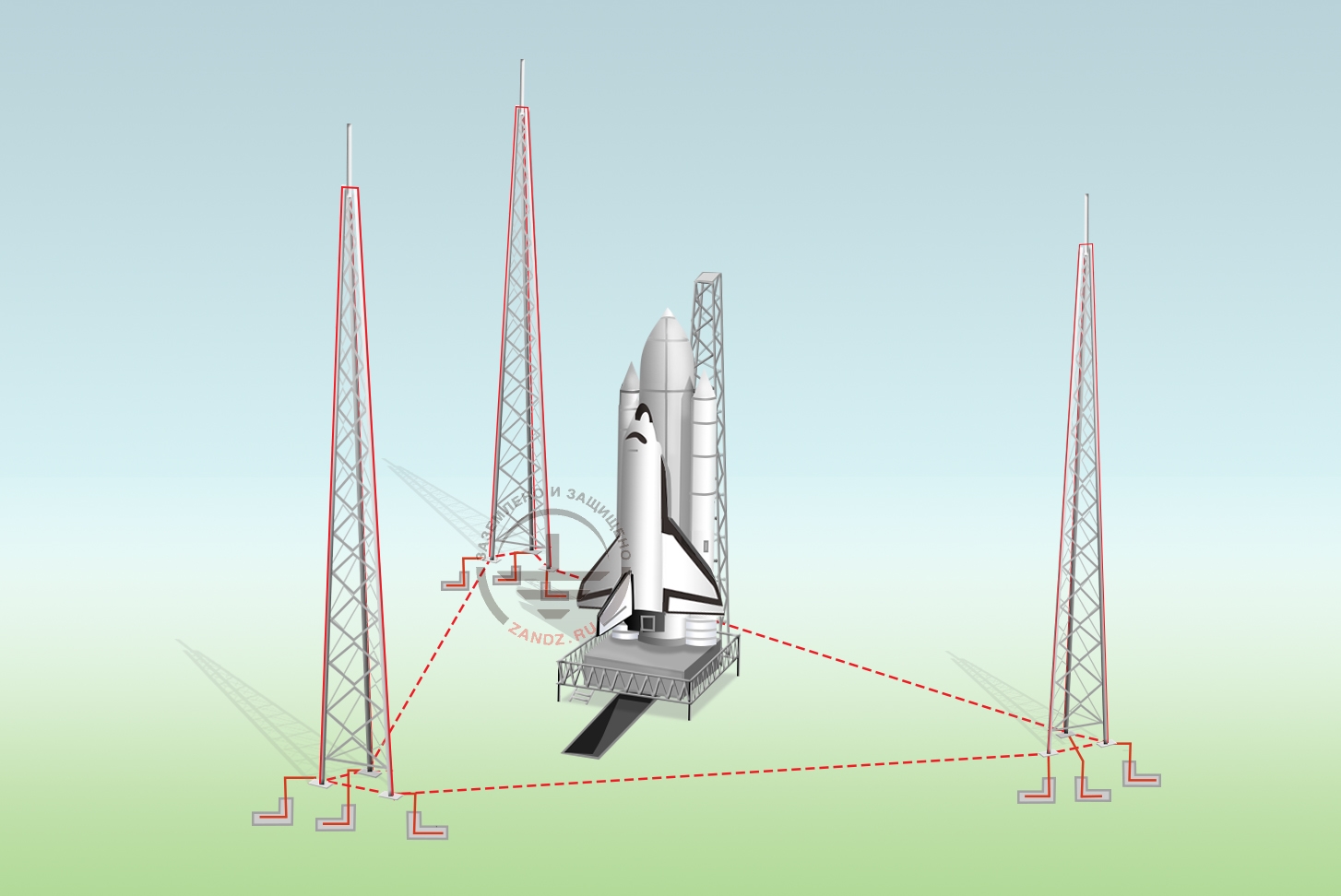
Rod lightning masts mounted on towers
Rod lightning arrester (or air-terminal mast) is a vertical device usually from 1 to 20 meters high on the roof of the building or near it, mounted so that the protection zone covers the protected object. Special clamps,used when installing masts, allow to fix them to both vertical (wall) or horizontal (ground, roof) surfaces. Two down conductors are mounted from every mast. If a lightning arrester is placed on the roof of the structure, then the used grounding device presents itself a horizontal loop, which is reinforced at the points of downdrop of down conductors by vertical ground electrodes. A grounding device of freestanding masts is performed by three vertical ground electrodes, united to each other by the type of a "chicken leg". Rod lightning arresters (masts) are selected mainly for protection of small buildings, the architecture of which is not complicated.
Catenary wire lightning arrester
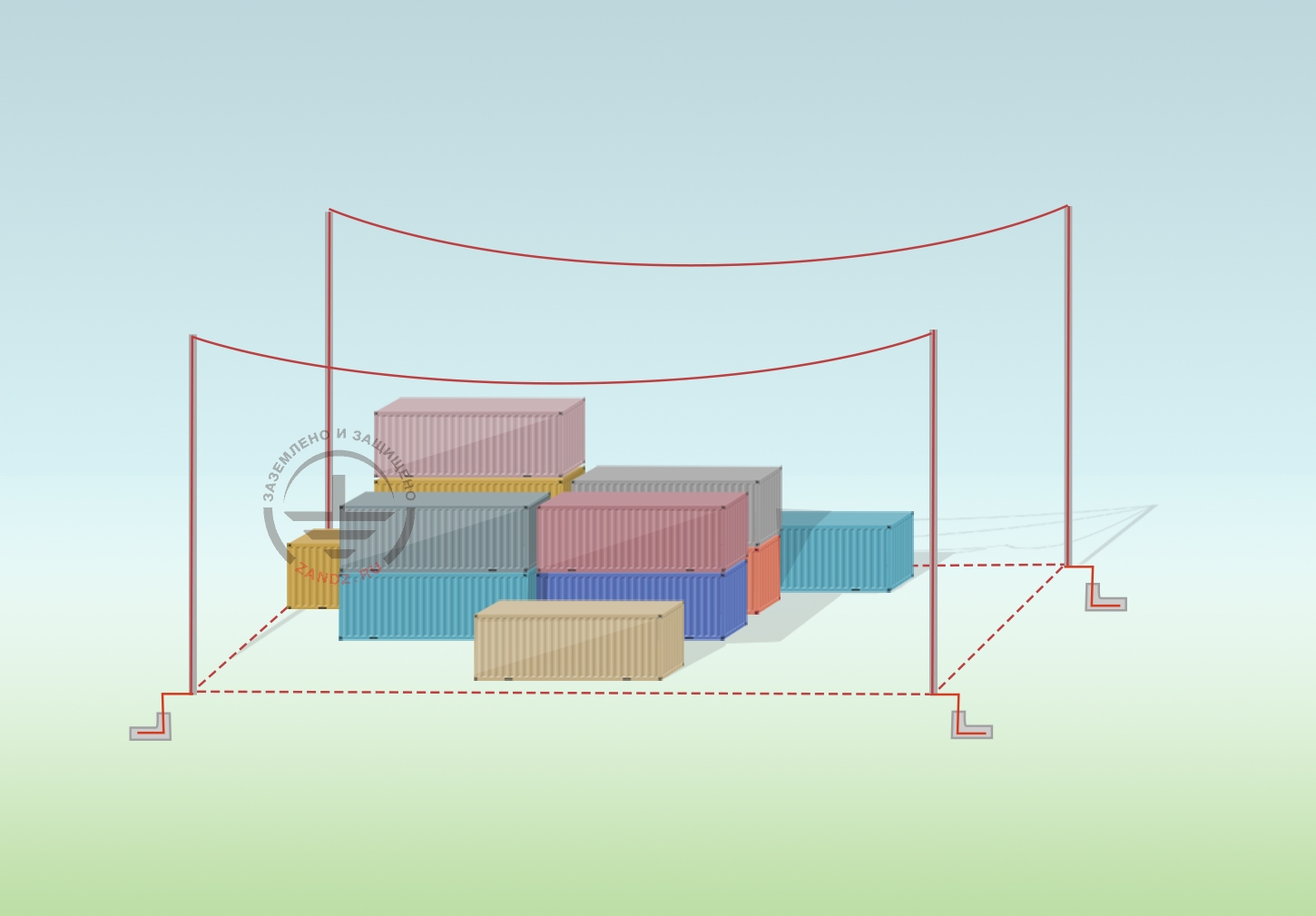
Catenary wire lightning arrester
Construction of a catenary wire lightning arrester consists of two masts and a steel wire stretched between them. One down conductor with a ground electrode is connected to every end of the wire by the type a "chicken leg". At a proper positioning of supporting masts, lightning strikes go to the ground outside the protected object. Catenary wire lightning protection is widely used for low-rise buildings. Rod and catenary wire lightning arresters are subdivided into single, double and multiple, forming a common area of the object's protection. Multiple lightning arresters are used to protect large buildings or multiple buildings, occupying a large area.
Lightning protection mesh cage
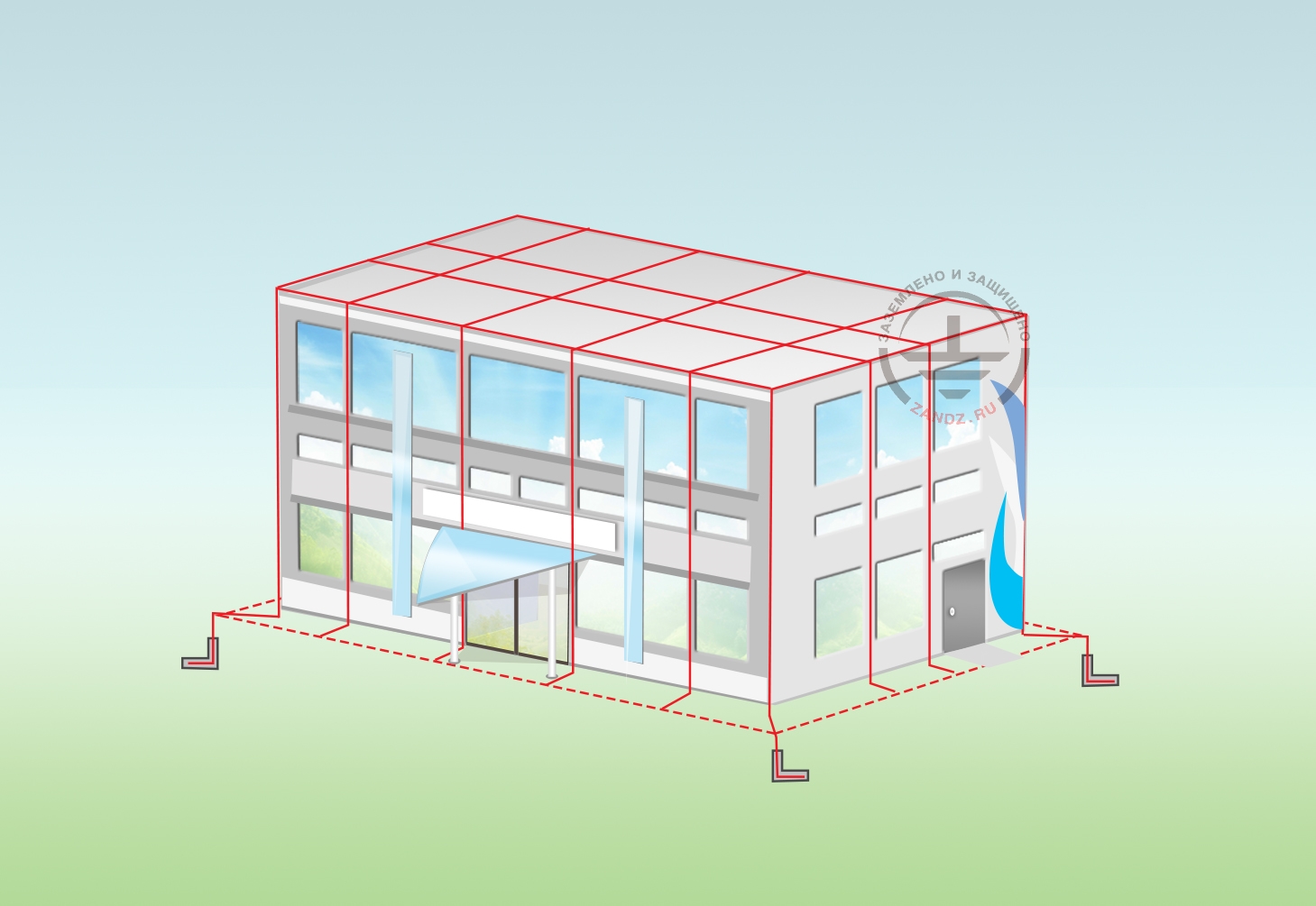
Lightning protection mesh cage mounted on the roof of the building
Construction of a lightning rod is made in the form of a mesh made of metal rods on the roof of the protected structure. Lightning protection mesh cage is placed on the roof of the building with an interval (mesh size) from 5x5 m to 20x20 m, depending on the category of lightning protection facility. A common question that arises at the design - is it possible to put lightning protection mesh cage directly on the roof top. In fact, the net can be put directly on the roof top or under the insulation (see p. 2.11. in the manual of AD 34.21.122-87). According to the instructions of industry standard 153 3.2.2.4. if the temperature rise presents danger for the object, the distance between the down conductor and the combustible roof or wall should be greater than 0.1 m. In this case, a metal clamp could be in contact with a combustible wall. If a wall or a roof is combustible, but the temperature increase is not dangerous for them, it is allowed to mount directly to the wall.
Down conductors are mounted around the perimeter of the air terminal with the interval from 10 to 25 m (depending on the security level). The protected structure roof type (soft or hard) determines the method of "mesh cage" fixation to the roof surface. Subject to the conditions of non combustible base, a lightning protection mesh cage can be laid in a "roofing pie". For this type of air terminal a ground electrode system presents itself a closed horizontal loop, reinforced at the points of down conductors' downdrops.
3. Categories of lightning protection
Selection of type of an air terminal depends on lightning protection category of the structure.
The standards fix three categories of lightning protection devices, depending on the explosion and fire risk, capacity, fire resistance and purpose of protected sites, as well as annual average duration of thunderstorms in the geographical area of the object's location. See lightning protection category in table № 1 from pragraph 1.1. in AD 34.21.122-87:
| Buildings and structures | Location | Protection zone type at the use of rod and catenary wire lightning arresters | Categories of lightning protection | |
|
1
|
Buildings and structures or their parts, premises of which refer to zones of classes E-I and E-II according to EIC. | On the whole territory of the USSR | Zone A | I |
|
2
|
The same classes of E-Ia,E-Iб, E-IIа | In areas with an average duration of thunderstorms 10 hours per year or more | At the expected number of lightning strikes of buildings or structures per year N> 1 - Zone A; when N≤1 - Zone B | II |
|
3
|
Outdoor facilities, creating zone E-Id in accordance with the EIC | On the whole territory of the USSR | Zone B | II |
|
4
|
Buildings and structures or their parts, premises of which refer to zones F-I, F-II, F-IIа according to the EIC. | In areas with an average duration of thunderstorms 20 hours per year or more | For buildings and structures of I and II levels of fire resistance at 0.1 2- Zone A | III |
|
5
|
Small rural structures of III - V degrees of fire resistance, the premises of which refer to zones F-I, F-II, F-IIа in accordance with the EIC. | In areas with an average duration of thunderstorms 20 hours per year or more, where N< 0,02 | - | III |
|
6
|
Outdoor facilities and open warehouses, creating zone F-III according to the EIC | In areas with an average duration of thunderstorms 20 hours per year or more | At 0.12 - Zone A | III |
|
7
|
Buildings and structures of III, IIIa, IIIb, IV, V levels of fire resistance, in which there are no premises, referred to areas of explosion and fire classes according to the EIC. | The same | At 0.12 - Zone A | III |
|
8
|
Buildings and constructions of light metal structures with combustible insulation (IVa degree of fire resistance), in which there are no facilities, referable to the zones o explosion and fire classes according to the EIC. | In areas with an average duration of thunderstorms 10 hours per year or more | At 0.12 - Zone A | III |
|
9
|
Small structures of III-V levels of fire resistance, located in rural areas lacking premises referable to the zones of explosion and fire classes according to the EIC. | In areas with an average duration of thunderstorms 20 hours per year or more for III, IIIa, IIIb, IV, V level of fire resistance at N <0,1, for IVa level of fire resistance at N <0,02 | - | III |
|
10
|
Buildings of processing centers, including those located in urban area | In areas with an average duration of thunderstorms 20 hours per year or more | Zone B | II |
|
11
|
Livestock and poultry buildings and structures of III-V degrees of fire resistance: for cattle and pigs for 100 heads and more, for sheep for 500 heads or more, for poultry for 1,000 heads or more, for horses for 40 heads and more | In areas with an average duration of thunderstorms 40 hours per year or more | Zone B | III |
|
12
|
Smoke and other pipes of businesses and boilers, towers and garrets of all assignments 15 m and higher | In areas with an average duration of thunderstorms 10 hours per year or mor | - | III |
|
13
|
Жилые и общественные здания, высота которых более чем на 25 м превышает среднюю высоту окружающих зданий в радиусе 400 м, а также отдельно стоящие здания высотой более 30 м, удаленные от других зданий более чем на 400 м | In areas with an average duration of thunderstorms 20 hours per year or more | Zone B | III |
|
14
|
Отдельно стоящие жилые и общественные здания в сельской местности высотой более 30 м | The same | Zone B | III |
|
15
|
Public buildings of III-V degrees of fire resistance of the following purposes: kindergartens, schools, boarding schools, hospitals, dormitories and dining rooms of health and recreation facilities, cultural-educational and entertainment establishments, office buildings, railway stations, hotels, motels and campgrounds | The same | Zone B | III |
|
16
|
Public entertainment facilities (auditoriums of outdoor cinema, grandstands of outdoor stadiums, etc.) | The same | Zone B | III |
|
17
|
Buildings and facilities, which are monuments of history, architecture and culture (sculptures, obelisks, etc.) | The same | Zone B | III |
Categories of lightning protection according toAD 34.21.122-87
I category of lightning protection
For lightning protection of buildings referring to category I, air terminal mast or catenary wire lightning arresters,
see. paragraph 2.1. in AD 34.21.122-87. It is obligatory to ensure protection zone of type A in accordance with the requirements of annex 3.
II category of lightning protection
For lightning protection of II category structures, with a non-metallic roof, air terminal masts or catenary wire lightning arresters are used, they are mounted in isolation or on the protected object, see p. 2.11 in AD 34.21.122-87. At the same time it is imperative to ensure the protection zone in accordance with the requirements set out in the table article and Annex 3 to the AD 34.21.122-87. If lightning protection devices are located in the facility, then not less than two down conductors are required for every air terminal mast or a stand of catenary wire lightning arrester. For lightning protection of facilities, the pitch of which does not exceed 1: 8, lightning protection mesh cage can be used.
Steel wire with the diameter not less than 6 mm is used as a material for manufacturing of lightning protection mesh cage. The construction with a mesh interval of not more than 6x6 meters is placed on the roof of the building over or under the refractory materials. Metal constructions, towering over the roof of the structure, should be connected to the lightning protection mesh cage and non-metallic should be equipped with additional devices of lightning protecton, fixing them with a "mesh cage".
Structures with steel trusses, the roofing of which are built with the use of fire-resistant materials, do not require installation of lightning protection devices. Metal roofing of structures irself, acts as an air terminal. All non-metallic elements of the protected object towering aver the roof should be equipped with lightning protection devices. Down conductors are mounted on a metal roof or lightning protection mesh cage with an interval of 25 m along the perimeter of the building. Requirements of paragraph 2.6 of AD 34.21.122-87 are obligatory for all types of lightning rods, used to protect buildings of category II.
III category of lightning protection
For lightning protection of structures related to category III, one of the methods mentioned above (air-terminal, catenary wire of mesh cage lightning rods) is used in compliance with the applicable requirements.
Where possible, metal structures of the protected object are used as down conductors. A prerequisite for this is a continuous electrical coupling in the conjunctions of constructions with the rest of external lightning protection system (lightning rods and ground eletrode systems). Down conductors placed outside of the buildings should be mounted at the distance of not more than 3 m from entrances or in places not accessible for people's touching.
The govering documents on the organization of lightning protection of ground objects do not foresee any requirements to the distance between individual lightning rods and the protected object, its underground utilities. Applying lightning protection mesh cage for buildings of category III, it is necessary to foresee an interval between its cells not more than 12 x 12m.
4. Protection zones of rod and catenary wire lightning rods
Selection of number and height of rod and catenary wire lightning arresters must be carried out with the help of calculation of their protection zones.
A protected zone is the area of the given geometry in the vicinity of an air terminal, where the probability of a direct lightning strike to an object does not exceed a predetermined value.
To provide lightning protection of a construction on the level of required safety, the entire volume of the protected object must be located in the air terminal protection zone.
An individual air terminal mast provides a protection zone in the form of a circular cone with the height h0
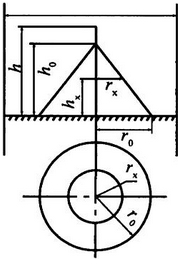
Protection zone of an individual rod lightning arrester
Individual catenary wire lightning arrester provides protection zone in the form of an isosceles triangle, the apex of which is at a height h0
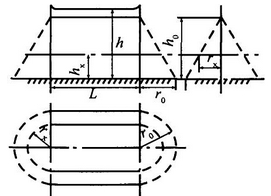
Catenary wire lightning rod protection zone
Calculation of protection zones of rod and catenary wire lightning rods is carried out according to industry standard 153-343.21.122-2003.
5. Select the type of lightning rod
Subject to everyrthing said above, we come to the conclusion that choice of type of a lightning rod must be made on the basis of building structures and materials of their roofing, with the obligatory consideration of lightning protection category and compliance with all necessary requirements of AD 34.21.122-87 and industry standard 343.21.122-2003.
Carrying out lightning protection of structures with the help of rod and catenary wire lightning arresters, they are placed in such a way that the entire object is within their protection zone, calculated for each type of a lightning rod according to industry standard 153-343.21.122-2003.
When choosing lightning protection mesh cage, it is important to consider that the interval between cells (cell sizes) is determined by the categories of lightning protection, see AD 34.21.122-87.
For a comprehensive lightning protection combined types, such combined types as wire-rod may be applied. The "mesh cage" is often combined with rod lightning arresters which provides a fairly reliable protection.
Extensive use of rod lightning erresters is due to its simplicity and relatively low cost of manufacture. Basically, air terminal masts are choosen to protect small structures with simple architecture. For lightning protection of large buildings or multiple buildings, occupying a large area, multiple rod lightning arresters are used.
Catenary wire lightning rods are chosen to protect very extended objects. Use of such lightning rods is economically comparable to rod lightning protection devices, but they proved themselves less reliable in operation.
At the present day, lightning protection mesh cage is perhaps the most common device of lightning protection of buildings referred to categories II and III.
However, modern scientific community does not confirm the efficiency of its use in the protection against direct lightning strikes, due to insufficient increase of this air terminal's height (2-3 cm) obove the object, while providing insufficient reliability of the structure's protection (more details in webinar "Questions and issues of regulatory documents").
Presence of an installed external lightning protection system does not guarantee complete protection against all lightning effects. It is necessary to protect the object in complex to protect against secondary effects: elements of external lightning protectionand internal lightning protection, which presents itself a set of surge protection devices (SPDs).
See also:
- Grozoizolyator - a system of complete isolation from a lightning strike
- Lightning protection and grounding
- Useful materials for designers: articles, recommendations, examples
Related Articles:



